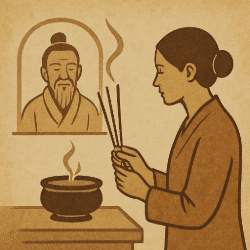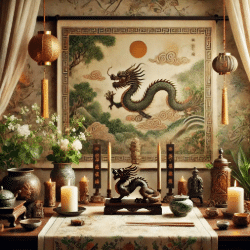Taoism can feel mysterious at first. But sometimes, what seems mystical is just quietly practical. Take incense. Maybe you’ve seen it spiraling gently in a temple or curling upward in someone’s backyard garden. Maybe you’re wondering: Do I need three sticks? Just one? Does it matter what kind I buy? Let’s walk through it together.
What kind of incense should I use in Taoist practice?
The simplest answer? Natural incense—resin- or wood-based. Taoist incense is traditionally made from:
Sandalwood (calming and grounding)
Aloeswood (used in ceremonial settings)
Frankincense or Myrrh (sometimes borrowed from older folk traditions)
Herbal blends (like mugwort or Chinese herbs)
Avoid synthetic, perfumed sticks. They don’t align with Taoist principles of simplicity and harmony. Brooke tip? If the ingredients list reads like a perfume ad, pass.
Disclosure: As an Amazon Associate, WMI earns from qualifying purchases. This means WMI may receive a commission if you click on links to products on this website and make a purchase, at no additional cost to you.
How many sticks should I burn?
Here’s where tradition, symbolism, and intention all mix:
One stick: Everyday use, solo practice, or meditation.
Three sticks: Honoring the Three Pure Ones (Taoist trinity); used in rituals or offerings.
Five sticks: Less common, but used in some sects to represent the five elements (wood, fire, earth, metal, water).
You’re not breaking any sacred rule by lighting just one. It’s about purpose. If you’re starting your day with intention, one is just fine.
Do I need an altar to burn incense?
Nope. You can create a simple space:
A small bowl of sand
A rock or wood slab
A dedicated corner with a candle or plant
Altars are meaningful, but not required. In Taoism, spirit is everywhere. Even a quiet windowsill works.
When is the best time to burn incense?
Think rhythm, not rules. Most Taoist practitioners prefer:
Morning: To start the day with balance
Evening: To wind down and release static energy
During practice: Qi Gong, meditation, writing, prayer
Burning during solar terms, festivals, or lunar phases is also common—but you don’t need to track a calendar. Just follow your breath.
Can I use incense for meditation or Qi Gong?
Absolutely. It’s especially helpful when used to:
Mark the beginning and end of a session
Focus your attention on breath and space
Create a calming sensory field
Brooke says: Think of incense like a bell. You don’t stare at the smoke. You just let it signal your shift in state.
Is incense required to be Taoist?
No, and that’s an important thing to say aloud. Taoist practice is about cultivating harmony, not checking boxes.
Some Taoist traditions don’t use incense at all. Others use it lavishly. It’s a personal decision, not a test of your sincerity.
Is it okay to burn incense without believing in deities?
Yes. Incense isn’t just about gods. It’s about space. It marks sacredness, time, and transition.
Even if you’re unsure about spirits, incense can:
Center your mind
Help you step into a deeper stillness
Invite reverence into the moment
Belief can grow. But practice often begins with curiosity.
How long should I let incense burn?
Typical sticks last 20–40 minutes. That’s often just right for:
Meditation sessions
Morning routines
Wind-down time in the evening
You can always extinguish early by pressing the ember into sand. That’s not disrespectful—it’s mindful.
Can incense help cleanse or protect a space?
Yes—if your intention aligns with the action. Taoist priests sometimes use incense to:
Bless or purify a home
Honor ancestors
Open or close ritual space
At home, this can look like a simple walk through each room with a lit stick, letting the smoke gently reach the corners. No need for chanting. Just walk slow, breathe deep.
What’s the meaning behind the rising smoke?
The rising smoke is a metaphor:
Spiraling upward: Connection between Earth and Heaven
Dissolving form: Letting go of attachment
Scent lingering: The trace of intention or prayer
In Taoism, form becomes formless. Incense shows this.
Final thoughts
Burn incense because you want to. Because it soothes. Because it helps you remember that you are part of something greater. There’s no right amount, no certification needed. Just light the stick, place it gently, and let it do its quiet work.
As Laozi said, “The way is empty, yet it does not fail.” A single thread of smoke might be all it takes to remember that.
Frequently Asked Questions About Taoist Incense
How many incense sticks should I burn in Taoist practice?
One stick is appropriate for daily practice or meditation. Three sticks are often used for ritual offerings, symbolizing the Three Pure Ones. Five sticks may represent the five elements in some traditions.
Do I need an altar to burn incense?
No. A dedicated space like a small bowl of sand, a windowsill, or a corner table can serve just as well. In Taoism, intention matters more than formality.
What type of incense is best for Taoist use?
Natural incense made from sandalwood, aloeswood, or herbal blends is preferred. Avoid synthetic or heavily perfumed incense.
Can I use incense without believing in gods or spirits?
Yes. In Taoism, incense is as much about presence and mindfulness as it is about worship. It helps mark sacred space and still the mind.



